Best Trekking Poles 2024 Hiking & Backpacking
Last Updated: March 14, 2024
High Performance Carbon Fiber Trekking Poles
Here we have the best trekking poles for a wide array of hiking needs. Compared to the average walking sticks, these trekking poles are lighter weight, stronger, and of better value. We’ve tested them on long trails like the PCT and AT, and off-trail in Alaska, Patagonia, Utah, and Wyoming. We hike with trekking poles 100% of the time, and recommend you do too!
Our goal is to help you find the best trekking poles for your specific hiking and backpacking needs that fit your budget. And that’s why we’ve included a wide array of models at different price points, in different weight classes, and with differing levels of adjustability. Some are designed for sturdiness in rough terrain, while others are featherweight for crushing long mileage on-trail.
Keep scrolling to view our quick picks, comparison table, and reviews of the best trekking poles. Or jump ahead for buyer info and pro tips. And while you’re here, gear up with our guides to hiking shoes, ultralight daypacks, backpacking packs, or browse the 9 lb backpacking gear list to complete your kit.
You make Adventure Alan & Co possible. When purchasing through links on our site, we may earn an affiliate commission at no additional cost to you. Here’s why you can trust us.
Quick Picks: Best Trekking Poles of 2023
- Best On Trail: Gossamer Gear LT5
- Best All-Purpose: REI Co-op Flash Carbon
- Best Value: Zpacks Carbon Fiber Trekking Poles
- Best Under $100: Cascade Mountain Tech Carbon Fiber
- Best Off Trail: Black Diamond Alpine Carbon Cork
- Top Pick Collapsible: Black Diamond Distance Carbon FLZ
- Top Pick Collapsible: Leki Black Series FX
- Best Ultralight Fixed Length: Black Diamond Distance Carbon
Comparison Table: Best Trekking Poles of 2023
| Trekking Poles | Price ($) | Weight (oz) | Adjustability |
| Gossamer Gear LT5 Carbon | 195 | 9.8 | 2 Twist Locks |
| REI Co-op Flash Carbon | 169 | 13.6 | 2 Flip Locks |
| Zpacks Carbon Fiber | 120 | 14.4 | 2 Flip Locks |
| CMT Carbon Fiber | 65 | 15.6 | 2 Flip Locks |
| BD Alpine Carbon Cork | 200 | 17.1 | 2 Flip Locks |
| BD Distance Carbon FLZ | 210 | 12 | 1 Flip Lock |
| Leki Black Series FX Carbon | 270 | 16 | 1 Flip Lock |
| BD Distance Carbon | 170 | 6.3 | None |
Best Trekking Poles – On Trail
Gossamer Gear LT5 Carbon Trekking Poles
The Gossamer Gear LT5 Carbon are our favorite ultralight trekking poles, and our go-to for most hikes.
- Price: $195
- Weight: 9.8 oz
- Material: Carbon Fiber
- Adjustability: 2 Twist Locks
- Off-Trail Compatible: No
- Pros: Ultralight. Padded wrist straps. Joy to use.
- Cons: Expensive. Twist Lock. Not for off-trail
Features
These feather light poles weigh less than 10 ounces for the pair. They are perfect for fast and efficient hiking, and the best trekking poles for use on-trail. We recommend them for thru-hikes, fast packs, or anyone who strives to pack ultralight.
The Gossamer Gear LT5s deliver a light and accurate swing, a stiff and precise pole plant, and a solid feel. They have foam grips that look like cork.
A twist locking adjustability mechanism saves weight compared to flip locks, but is more prone to clogging. It’s harder to fix because the mechanism is on the inside of the pole.
For $195, these poles are definitely on the expensive end. But considering their excellent performance, we still feel they’re a reasonable value.
Lastly, these LT5s are ultralight poles. The carbon fiber is strong, but they aren’t designed to handle extreme off-trail stress like scree fields.
Verdict
The Gossamer Gear LT5s are out go-to trekking poles for most hikes. The only times we choose other poles are when traveling through rugged off-trail, cross country terrain.
Best Trekking Poles – All-Purpose
REI Flash Carbon Trekking Poles
The REI Flash Carbon Trekking Poles are nearly everything we’d hope for in a $150 pair of trekking poles, and a great do-it-all pick.
- Price: $149
- Weight: 13.6 oz
- Material: Carbon Fiber
- Adjustability: 2 Flip Locks
- Off-Trail Compatible: Yes
- Pros: Ultra-secure flip locks. Lightweight. Good value. Sturdy.
- Cons: Grip does not extend down.
Features
Constructed with sturdy carbon fiber, the REI Co-op Flash Carbon Trekking Poles weigh less than seven ounces per pole. They have an above-average sturdiness, and are strong and durable enough for light to moderate off trail travel.
We love the burly flip lock mechanism. It is very user friendly and secure, and outperforms most other poles in this regard.
Our biggest complaint is that they did not extend the foam grip below the handle. This seems like an oversight, as it’s common to want to hold the pole lower down when hiking uphill.
Verdict
The Flash Carbon Trekking Poles are some the best trekking poles all around, and they’re sold at a favorable price. We love the secure flip locks, we wish they had extended the foam grip lower.
Best Trekking Poles – Value
Zpacks Carbon Fiber Trekking Poles
At $120 per pair, or $60 a pop, the Zpacks Carbon Fiber Trekking Poles are an ideal blend of performance and value.
- Price: $120
- Weight: 14.4
- Material: Carbon Fiber
- Adjustability: 2 Flip Locks
- Off-Trail Compatible: Yes
- Pros: Great Value. Extended Grip. Padded Straps. Flip Locks. Sturdy.
- Cons: Midweight
Features
This is a well-rounded carbon trekking pole design and one of the best trekking poles for its price. They are constructed with two flip locks for easy adjustability.
The foam (or cork) handles are extended allowing for a secure low grip when traveling uphill. The cork version is slightly heavier, so we recommend foam. They even have slightly padded wrist straps
At 14.4 oz for the pair, they aren’t the lightest, but everyone agrees that they’re nice and strong. On the carbon fiber pole spectrum, we would describe them as midweight.
If you’re solo and relying on your poles to support an ultralight tent, then slightly heavier duty poles like these might be a good choice. They are midweight poles with a midweight shaft and should manage off-trail just fine.
Lastly, we love that you can purchase them individually. If one should fail, you don’t need to replace the entire pair. That’s very customer friendly. Thanks, Zpacks!
Verdict
A great value to performance ratio in a great all around pair of trekking poles. Only downside is that they’re a bit heavy.
Best Trekking Poles – Under $100
Cascade Mountain Tech Carbon Trekking Poles
The Cascade Mountain Tech Carbon Fiber Poles deliver the best value to performance ratio, bar none.
- Price: $65
- Weight: 15.6
- Material: Carbon Fiber
- Adjustability: 2 Flip Locks
- Off-Trail Compatible: Yes
- Pros: Incredible Value. Sturdy.
- Cons: Mid-tier weight. Plastic flip locks.
Features
We’ve taken the CMT carbon trekking poles all over the world and continue to be astounded by how well they perform relative to their price. We have used them on and off trail, and they performed excellently, even on treacherous cross country routes.
At 15.6 oz for a pair, they’re definitely midweight, and heavier than we prefer. But conversely, the heavier shaft frame adds strength, durability, and resilience to sudden extreme pressure events that might snap or bend other poles
The straps are durable and unexciting. The cork and/or foam grips extend down for a low hold, compatible with uphill travel. CMT poles come with a bunch of different baskets and tip attachments.
Our only complaint aside from the weight, is the flip locks. These mechanisms are plastic where more expensive models use metal. We find they are more prone to wiggling loose than others, but not significantly and this is a minor problem once you know what to expect.
Verdict
CMT Trekking Poles are the least expensive carbon fiber model, and their performance to value is unmatched. They are the best trekking poles for their price with very little to complain about.
Best Trekking Poles – Off Trail
Black Diamond Alpine Carbon Cork Trekking Poles
If you want a strong and sturdy midweight trekking pole dedicated to rugged off-trail -use, choose the Black Diamond Alpine Carbon Cork.
- Price: $200
- Weight: 17.1 oz
- Material: Carbon Fiber
- Adjustability: 2 Flip Locks
- Off-Trail Compatible: Yes
- Pros: Very Sturdy. Extended grip. Flip Lock.
- Cons: Mid-tier Weight. Expensive.
Features
These are the best trekking poles for challenging terrain, and they been supporting hikers and climbers on gnarly routes for decades. Black Diamond Alpine Carbon Cork Trekking Poles are famously sturdy and well loved by the community.
At 17.1 oz, they’re the heaviest pair on our list. But they’re also the toughest, sturdiest, and most durable. When you suddenly slip out and most of your weight is supported by a pole, this one is least likely to break.
The craftsmanship of these trekking pole is readily apparent. The metal flip locks are sturdy and secure. The cork grip is comfortable and foam extends the handle for uphill handling.
While the strap is lightly padded, we will note that BD makes thinner straps than most, and we have broken them before.
Verdict
When traveling through scree, bogs, snow, or any other treacherous terrain, we’re glad to have the sturdy Black Diamond Alpine Carbon Cork. Only downsides are the high price and mid-tier weight.
Top Pick – Collapsibility
Black Diamond Distance Carbon FLZ Trekking Poles
The Black Diamond Distance Carbon FLZ are our go-to poles when ultralight weight collapsibility matter most, such as a international thru-hike.
- Price: $210
- Weight: 12 oz
- Material: Carbon Fiber
- Adjustability: 1 Flip Lock
- Off-Trail Compatible: No
- Pros: Lightweight. Very packable. Extended grip.
- Cons: Marginal adjustability.
Features
Perfect for air travel, or terrain that involves routinely stashing your poles in your pack, the Black Diamond Carbon FLZ are the best trekking poles when it comes to stowage.
The namesake Z refers to its three-section design. Rather than one section telescoping into the next, each near-equal length third of the shaft is attached by a continuous cord running through its hollow center.
When the cord is pulled taught using BD’s proprietary SlideLock, you have a secure, full length trekking pole. When given slack, the pole can be folded into thirds and is much shorter than telescoping designs.
An additional 20cm of adjustability is granted by the singular FlickLock mechanism at the top. This is helpful for setting up trekking pole structures and customizing the fit to your exact height and arm length.
But with all of those incredible design benefits comes a few downsides. First off, the price. At $210, this is one of the most expensive pole on our list, and one of the most expensive on the market.
What’s more, this pole is plenty sturdy for on-trail travel, but we find it to be lacking structural durability for off trail use. Lastly, BD designs some pretty minimalist pole straps, and we’ve seen them break before.
Verdict
This is the most portable and stowable lightweight trekking pole, perfect for those who frequently travel to hike. Downsides are the high price, limited adjustability, and modest durability.
Top Pick – Collapsibility
Leki Black Series FX Carbon
Choose the Leki Black Series FX Carbon for a premium, collapsible, all-purpose trekking pole.
- Price: $270
- Weight: 16.0 oz
- Material: Carbon Fiber
- Adjustability: 1 Twist Locks
- Off-Trail Compatibility: Medium
- Pros: Very compact for stowing. Extremely high quality. Extended handle grip.
- Cons: Very expensive. Midweight. Adjustability maxes out at 130cm. Thin wrist straps.
Features
Starting from the top, we love Leki’s handle design. The ergonomic cork has a slightly forward slant for ease of use. And it comes with an extended foam grip beneath for challenging uphill travel. From top of cork to bottom of foam extension, these poles have some of the longest total grip areas we’ve tested.
The thin wrist straps beg durability questions, and we will revisit this review with an update after long-term testing. The weight savings are appreciated though and they do feel comfortable, despite the thinness.
Of course, the big story here is the 3-piece collapsibility, which is perfect for travel and far easier to stow on the outside of your pack than telescoping poles. This is a great pair to choose for trips that involve rope ladders and other put-those-poles-away terrain.
Pull the handle and pole body opposite to lock or unluck the interior tensioning line. Use the single flip lock to adjust the range from 110-130cm. While this accommodates most hikers, extra tall folks will find these to be too short. We do recommend them for hikers much taller than 6′.
You may be comparing these to the BD Carbon FLZ as another premium collapsible option. While both are great trekking poles, we prefer these for all-purpose use as they’re slightly burlier and more heavy duty. The BD poles are 25% lighter weight, and we would choose them for when collapsibility is required in a fastpacking pursuit.
Verdict
While new to us, these poles are primed to become our go-to for travel. They’re incredibly well-refined and well-made. Biggest downsides are the height limitaiton extra high price point.
Best Trekking Poles – Ultralight Fixed-Length
Black Diamond Distance Carbon Running Poles
If you want the lightest weight, simplest trekking poles, we recommend the Black Diamond Carbon Distance Running Poles. And you can use them just as well for trekking as you can for running.
- Price: $170
- Weight: 6.3 oz
- Material: Carbon Fiber
- Adjustability: None
- Off-Trail Compatible: No
- Pros: Super ultralight. Easy to hike or run with.
- Cons: Not adjustable. Not suitable for off trail. No extended grip.
Features
Hiking with a 3 oz Black Diamond Distance Carbon Running pole in each hand is a complete joy. You barely feel the weight, but still reap all of the mechanical advantages trekking poles offer.
These are the best trekking poles when it comes to minimizing weight, and they are incredibly easy to swing and accurate to plant. However, the low weight is also indicative of a thinner carbon fiber shaft construction, meaning we aren’t comfortable taking this one off trail.
This is a non-adjustable, fixed length pole. Make sure to grok the size guide! This comes with upsides and downsides. For starters, there are fewer mechanical failure points, no locking mechanisms to break or wiggle loose.
But the lack of adjustability makes this difficult to use with trekking pole supported structures. Unless the trekking pole height that your ultralight tent requires to pitch happens to be a near-exact match with your fixed length trekking pole size, then you’re out of luck.
Lastly, they’re much more difficult to transport and stow. This is a minor annoyance at home or on the way to the trail. But it can be outright obnoxious when you need your hands for class three terrain and can’t collapse them to stash in your backpack.
Verdict
These are the lightest, fastest, most freeing trekking poles you can use. That said, they aren’t the sturdiness and the lack of adjustability is not user-friendly. But if you know what you’re signing up for, these are great!
Pro Tips & Buyer Info
Why You Need Trekking Poles
Trekking poles reduce joint stress on the descent, take the sting out of steep climbs, and after extended use, you get so accustomed to hiking with poles that it can almost feel like you have a second set of limbs, acting as a balancing aid on tricky terrain. The best trekking poles can help you move faster and more smoothly on or off the trail, and as more and more hikers opt for a lighter base weight setup, trekking poles have taken the place of structural tent poles for a tarp-tent shelter setup, as opposed to the classic freestanding or semi-freestanding tent options.
How To Choose The Best Trekking Poles F0r Your Needs?
Choosing the best trekking poles for your needs depends on what type of terrain you’ll be crossing through. Hiking on an established, well-maintained trail calls for different poles than if you’re planning a journey through off-trail terrain like talus or other loose rock and debris. A carbon shaft is more expensive but lighter weight, and while they’re strong with a vertical load, carbon poles have a tendency to bend or break when shock-loaded from the side.
While aluminum poles are heavier, they are less expensive and are often more durable. The lightest weight poles are ideal for past-packing on established trails, or for endurance runs where every gram matters, but won’t be ideal for more rugged off-trail travel.
Your basket attachments on the end of your poles are also important, and can be switched out depending on tread. Wider baskets are ideal for staying more on top of snow, but will be frustrating on rocky or rooty ground.
While most models of trekking poles accomplish the same thing, most hikers will opt for an adjustable, collapsible set of poles with a simple locking mechanism that you can adjust up or down depending on terrain.
Aluminum Vs. Carbon Trekking Poles
Carbon poles have been a selling point (and reason for companies to brag about) over the past few years, and they have a lot of things going for them. When well-made, they are lighter and stronger than the most aluminum poles. But when you look at the weight and durability (durability is different than strength) when compared to the price point, there’s much to be said about using good old-fashioned aluminum poles.
Carbon poles are made of some of the lightest material available for trekking poles, and the material can actually reduce vibration and jarring on the trail. And while strong, carbon is more fragile than aluminum if it gets a sharp load from the side like the edge of a rock. We’ve broken a number of UL carbon poles in talus. And oftentimes you’re only saving a few ounces vs. aluminum if you compare and shop carefully.
Aluminum poles are made with super tough materials, making them even more durable than carbon. They also weigh just a few ounces more than comparable carbon poles, and you can often find them for a fraction of the price. When overloaded, aluminum poles are more prone to bending than snapping.
Overall, carbon poles are great for saving weight, and they’re our preferred material. But if you’re on a budget, a solid pair of aluminum poles are okay too.
Flip Lock Vs. Twist Lock Length Adjusters
Yet again, there are pros and cons to both. A flip lock can be easier to use, requires less maintenance, and feels more secure, but it is also more complicated mechanism, which means it has the potential for breakage and failure. We feel that on the whole, flip locks are less prone to pole slippage and jamming. Many of the best trekking poles use flip locks.
If they do go wonky, everything is accessible on the outside of the pole where you can see and manipulate it. One of the best things about flip locks is how fast they are to adjust on the go. Flip locks can also be more secure, as it’s one motion to lock the length down on the pole, which removes the guesswork of twisting.
A twist-lock can be lighter and more simple of a mechanism, but they require a bit more finesse to tighten correctly and without experience it’s hard to tell how tight to make them to prevent slipping, but not so tight that they are hard to loosen.
We also find that twist-locks are more prone to jamming. As such, you’ll also have to be sure to clean and maintain the twist locks, as dirt and debris that can clog them and prevent them from tightening securely. Finally if a twist-lock does jam all the parts are inside the pole so not accessible. This makes freeing up a jam harder vs. a flip-lock. All that being said, twist-locks have been around for decades and do work. You can get some great values in poles with twist-locks.
Cork vs Foam Handle Grip
When shopping for the best trekking poles, you may need to decide between cork and foam handle grips. Cork is considered more choice by the general hiking populace, but foam works great too. Both have upsides and downsides.
Cork grips feel better and grippier in the hand. Cork grips don’t absorb moisture and your hands might feel sweatier. Cork grip is slightly heavier, likely to add as much as half an ounce per pole. Cork grip is less durable in the long term. You don’t need to baby it, but it will accumulate micro abrasions and small gouges over time.
EVA Foam grips have a good hand feel, but less so than cork. They do wick and absorb moisture off your hand. This is more pleasant in hot dry weather, and less pleasant in wet/rainy weather. Foam is slightly lighter weight than cork, often saving as much as half an ounce per pole. EVA foam is more durable and long lasting, and more resistant to small scrapes and gouges.
Three-Section Telescoping Trekking Poles
These are the classic style of trekking poles, with three sections that telescope—or collapse—into themselves. These are secured with a flip-lock or twist-lock mechanism and are often highly adjustable. Most of the best trekking poles are of this type.
- Example: REI Co-op Flash Carbon
- Pros: Very adjustable, collapses down to a fraction of their fully extended length. Can be more durable than the z-fold poles, which are the other collapsible versions.
- Cons: Can be heavier, and the added mechanisms mean the pole construction is more complicated and thus has more places for breakage or failure.
One-Section, Fixed-Length Trekking Poles
One-section, fixed-length poles are exactly what they sound like. This style of pole consists of just one piece, which makes it sturdier, lighter, and oftentimes less expensive. Fixed-length poles often come in several different sizes based on your height. Note that not all fixed-length poles are one section. Some are z-fold, breaking down into three pieces. The best of these poles can be both very strong and very light. Most of the best trekking poles are not fixed length, as they are far less versatile.
- Example: Black Diamond Distance Carbon
- Pros: Simple construction (one piece) means a more durable pole with fewer opportunities for parts failure. They are also ideal for times when you won’t be traveling with your poles—no need to worry about collapsible poles for airline travel. Fixed-length poles can be lighter and less expensive as well.
- Cons: You can’t adjust them for going up or down steep sections of trail, and sometimes the length options aren’t perfectly suited for the person. Fixed-length poles are also more difficult to travel with, as they don’t collapse. And fixed-length poles not well-suited for use with trekking pole supported tents/shelters, although for some shelters, you can use them at an angle or possibly tie-off to them mid-shaft.
Z-Fold Trekking Poles
Z-fold poles are often made up of three pole segments held together with a hidden inner cord. The segments pull apart (but are held together by the elasticized cord) to collapse. That makes them the best trekking poles for quick stowing or travel.
- Example: Black Diamond Distance Carbon FLZ
- Pros: These poles stash quickly for when you transition between pole usage and stashing them in your pack. They are also lighter since their locking mechanisms are either much smaller or nonexistent.
- Cons: This style of pole has a higher instance of breakage than one-section poles or telescoping poles. The cordage running through the poles can break mid-cord or at attachment points. Additionally, these poles are either fixed-length or with very minor adjustment capabilities. These are also not well-suited for use with trekking pole supported tents/shelters.
Uphill vs Downhill With Trekking Poles
Trekking poles really shine on steep terrain, both uphill and downhill. Depending on the steepness of the trail, you’ll want to adjust your poles so your elbows sit at about 90 degrees when you grasp the grips and the pole tips are planted on the ground. I.e., longer poles for descents and shorter poles for ascents. It’s not necessary to adjust your poles for every incline and decline, but for extended ascents and descents, you’ll want to adjust them. The best trekking poles have quick-adjust mechanisms you can lengthen or shorten on the go.
When heading uphill, it’s important to keep your upper body as parallel to the trail as possible and not hunch over or “dump” your upper body into the poles. You should never feel like your shoulders are collapsing into the pressure on the poles, or being compressed into your pack straps. On the downhill, lengthen your poles enough that you don’t have to lean forward into grips or straps. (Alternatively, you can palm the top of your pole grips to quickly increase pole length for going downhill.) Staying upright will help maintain balance and avoid the dreaded faceplant downhill.
Trekking Pole Maintenance
Often an ignored part of gear maintenance, it’s important to clean the pole segments between hikes. Wipe debris, sand, grit off the shafts, pole ferrules, and any adjustment hardware such as flip locks and twist lock mechanisms. If your poles get wet, dry them out as much as possible before using them to set up your tarp-tent, and certainly before long periods of storage. Additionally, loosening and tightening any pole-adjuster hardware on a semi-regular basis prevents them from seizing/locking in place. If your poles keep collapsing, don’t panic. Chances are you just need to tighten a screw on one of the locking mechanisms.
Tip Replacement
Replacing the tips is an easy, inexpensive way to extend the life of your poles. Most of the best trekking poles have metal or carbide tips, which provide good traction on looser trails and ice. Rubber caps for your pole tips can serve as both shock absorption and traction for more buff trails, but both will end up wearing down after prolonged use. The more technical and rugged the trail, the faster the metal and rubber around the carbide will wear down but expect to replace your tips after around 500-700 trail miles. Once you lose the “edge,” it becomes more difficult to plant your poles and maintain traction, especially on extended sections of rock. The manufacturer of your trekking poles almost certainly sells replacement tips.
When Using Your Trekking Poles for Shelters
Most of the best trekking poles have a high adjustment range, which is desirable for shelters that use trekking poles for support. Additionally, the more stable the locking mechanism, the better. Look for the flip lock mechanism as opposed to “twist locks” Using your poles for shelter puts increased, extended pressure on the poles throughout the night or duration of shelter setup, and you want to be sure the mechanisms and structural integrity of your poles can withstand the dual-usage during on-trail movement and at night during static setup.
Tips for Traveling With Trekking Poles
Traveling to your hiking destination? You’ll need to pack your poles, which is somewhat easier said than done. In smaller luggage, you may need to take the poles apart to fit, and TSA does not technically allow trekking poles into carry-on luggage. While some hikers have had luck breaking down their poles and getting them through security with the individual sections broken down to fit into standard carry-on luggage, your safest bet is to check your bag with the poles.
Conclusion
The best trekking poles are incredibly useful for hiking. Whether helping you to balance on rough terrain, avoid slipping on snow or ice, or providing a support while fording a river, we consider the trekking poles to be essential for hiking, and even more so for backpacking. For general purpose hiking, we recommend adjustable carbon fiber trekking poles weighing 10-15 oz per pair. Happy hiking, and happy trails!
Leave a Reply
Want to join the discussion?Feel free to contribute!
Leave a Reply

 Hiker’s Guide To REI Co-op Member Coupon Moment Sale 2024
Hiker’s Guide To REI Co-op Member Coupon Moment Sale 2024
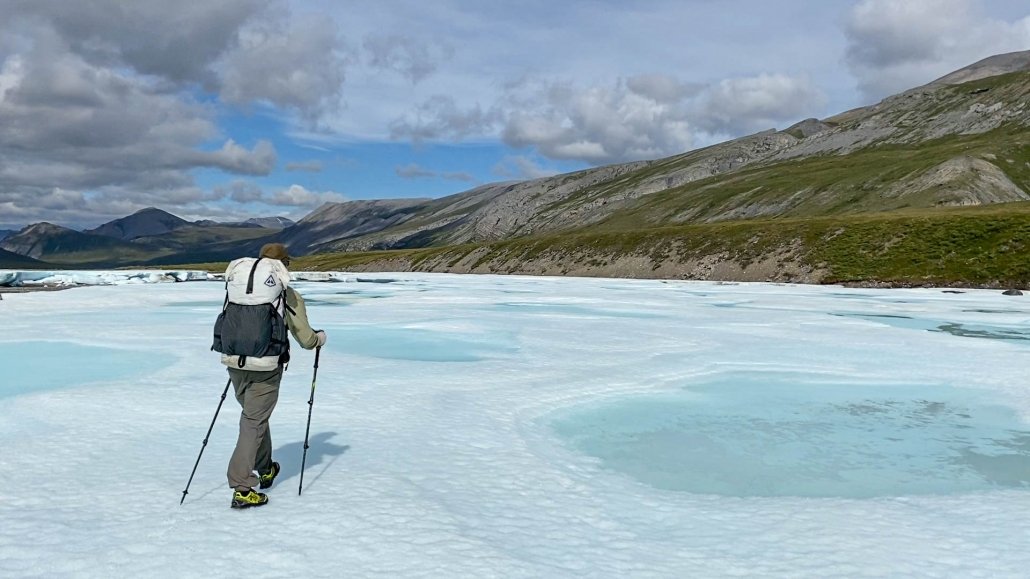
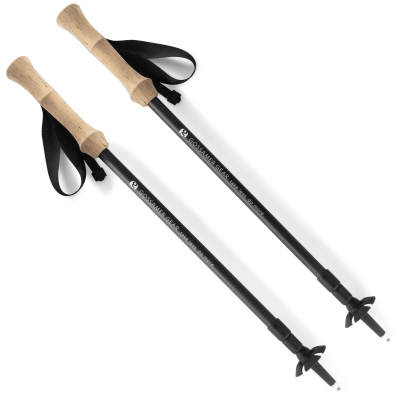
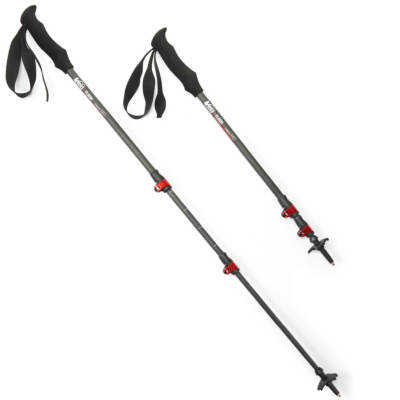
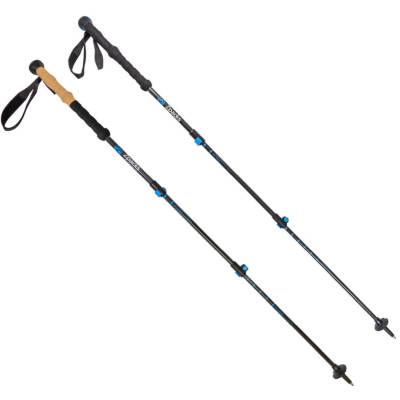
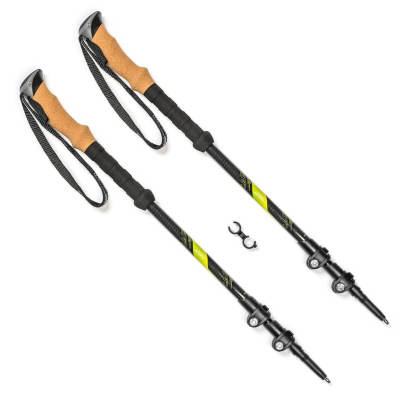
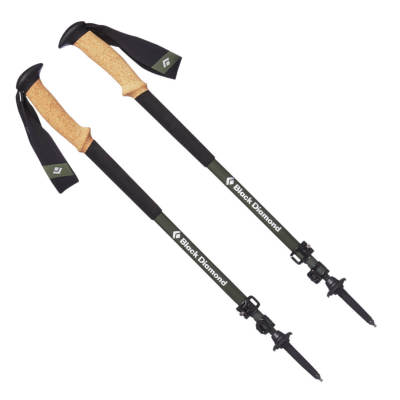
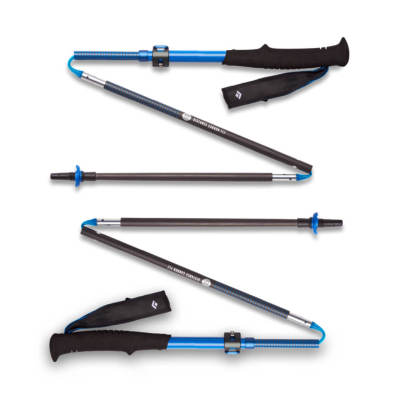
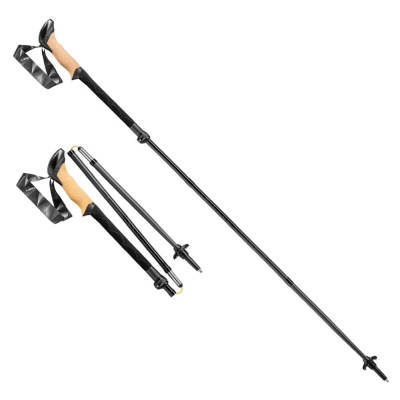
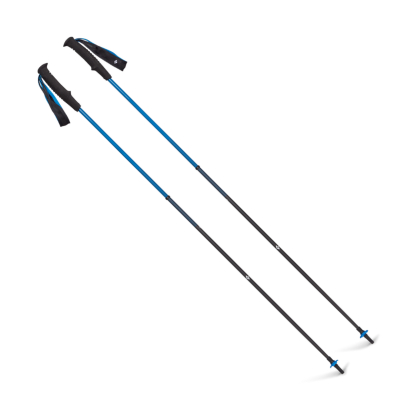
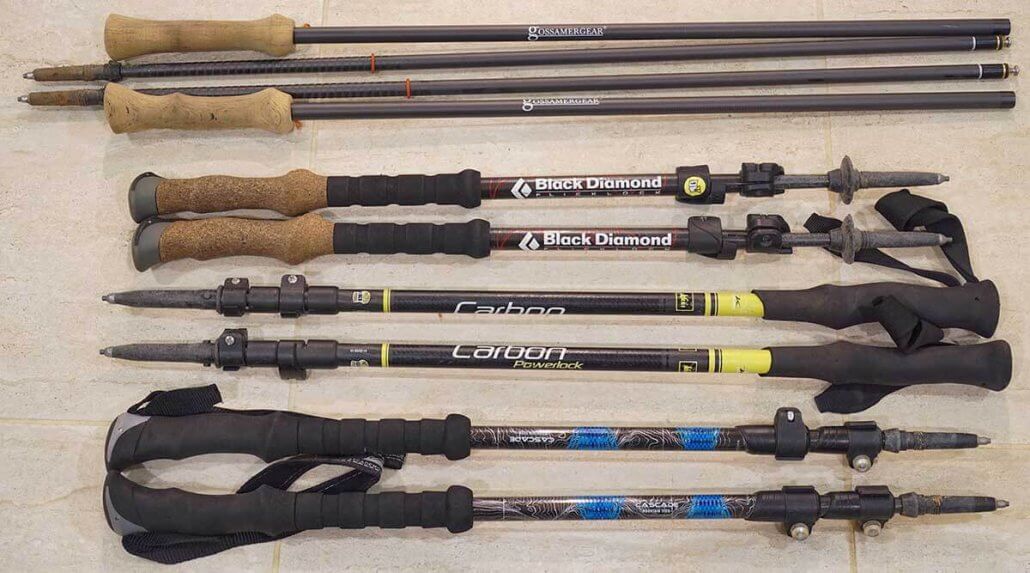

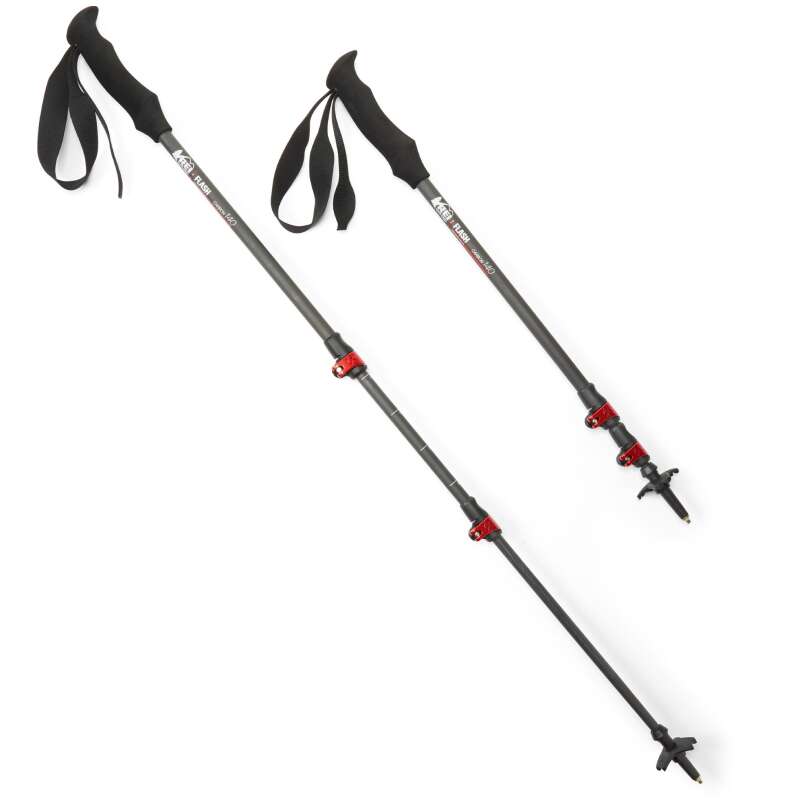
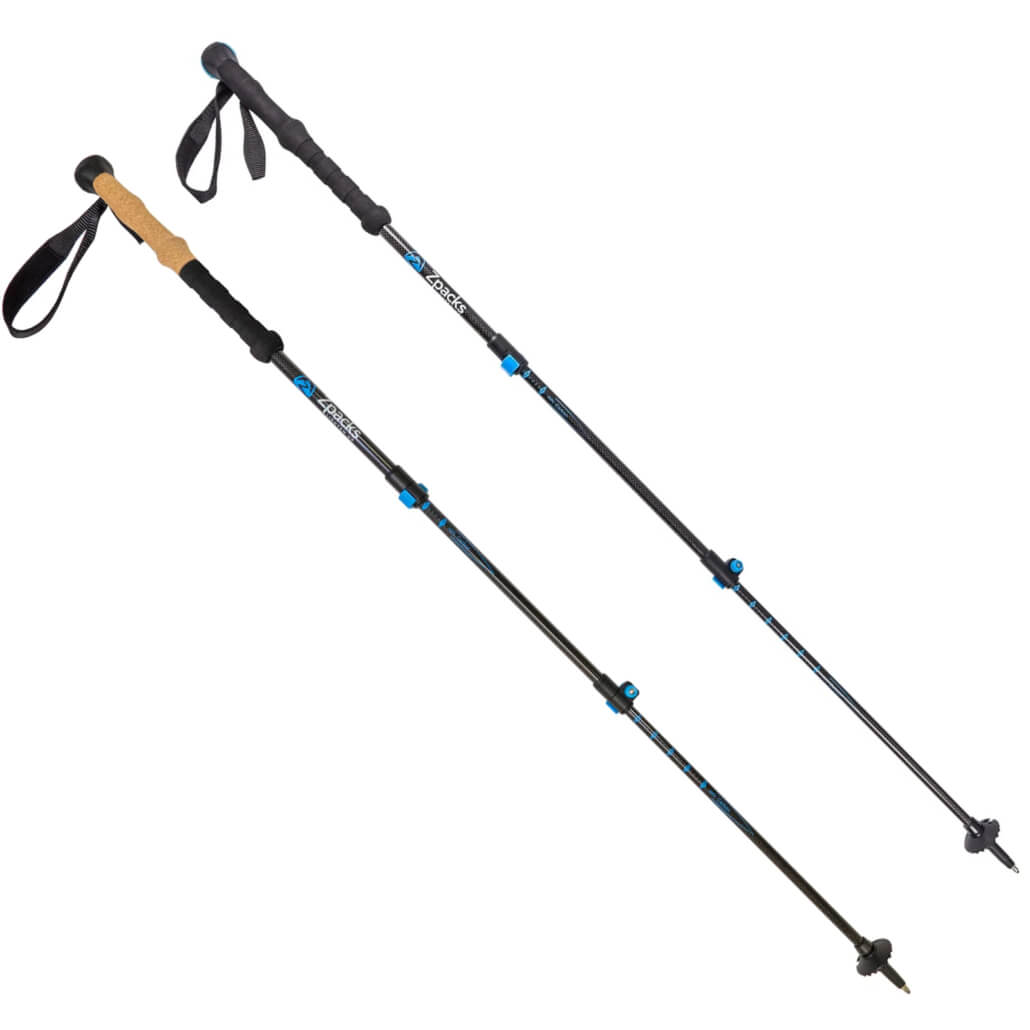


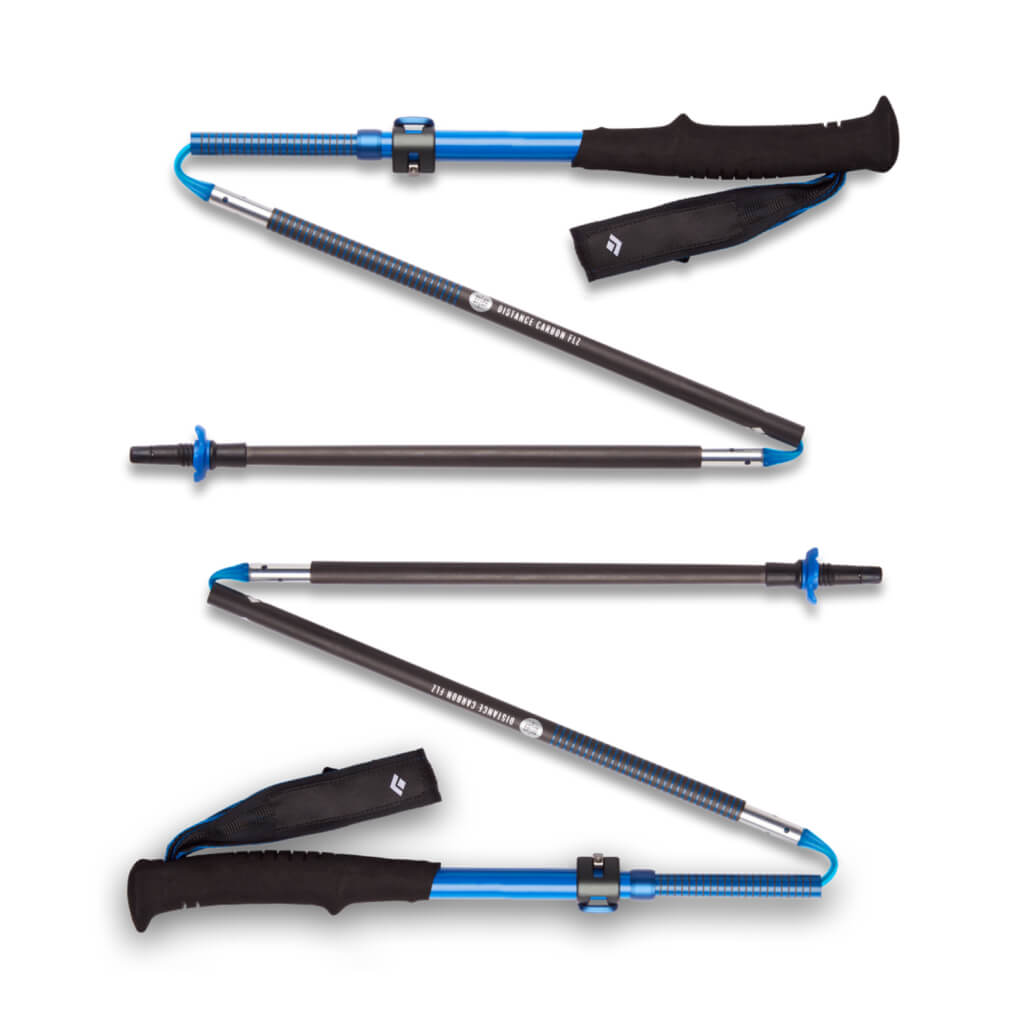
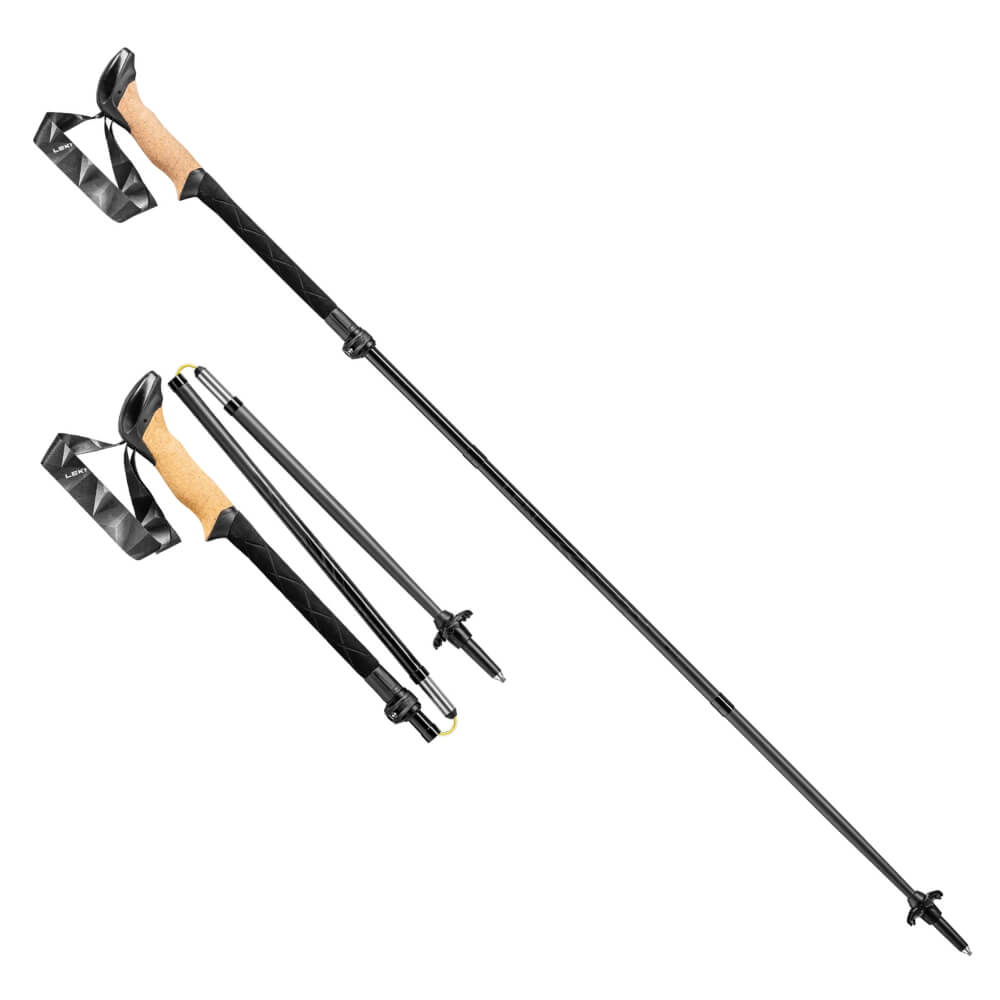
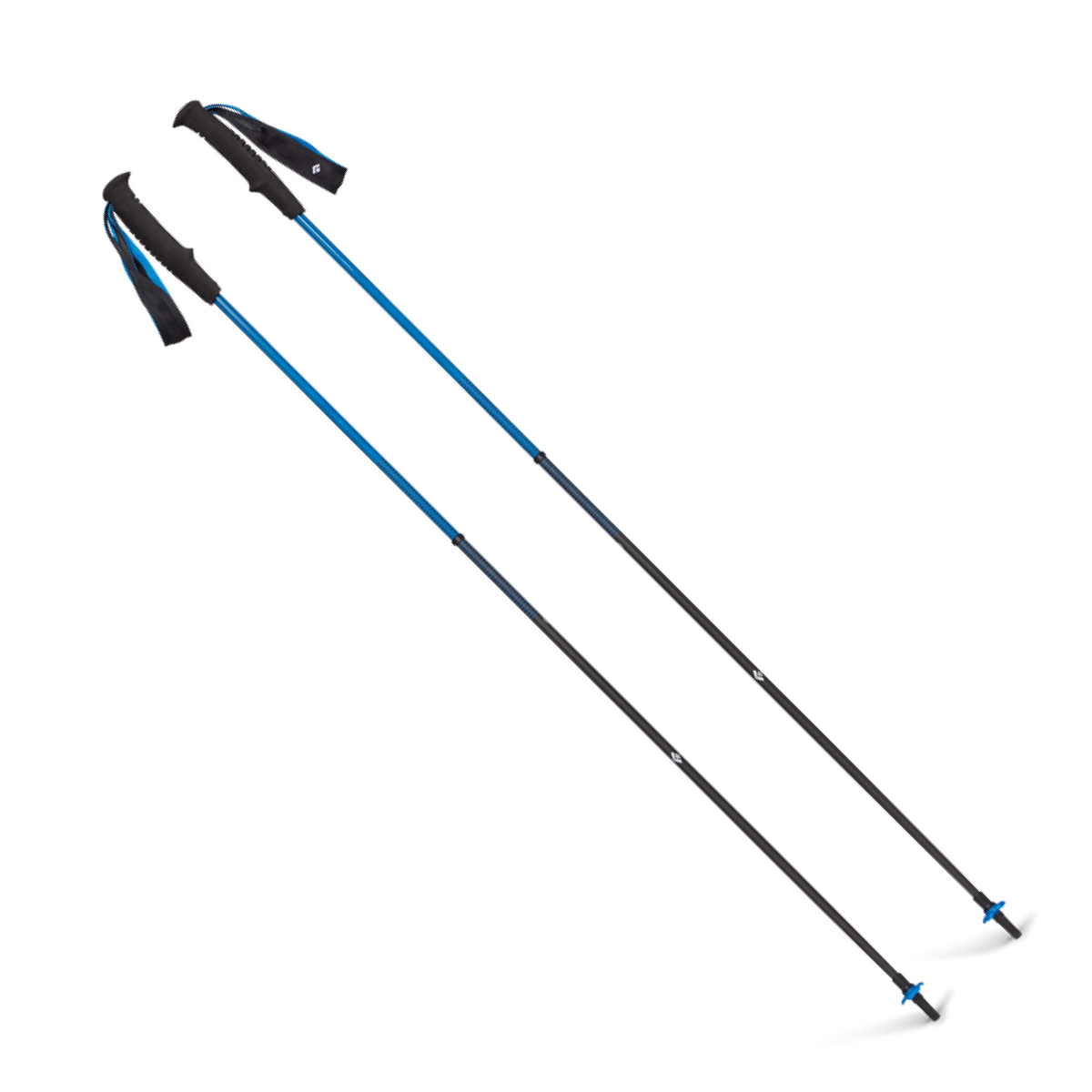

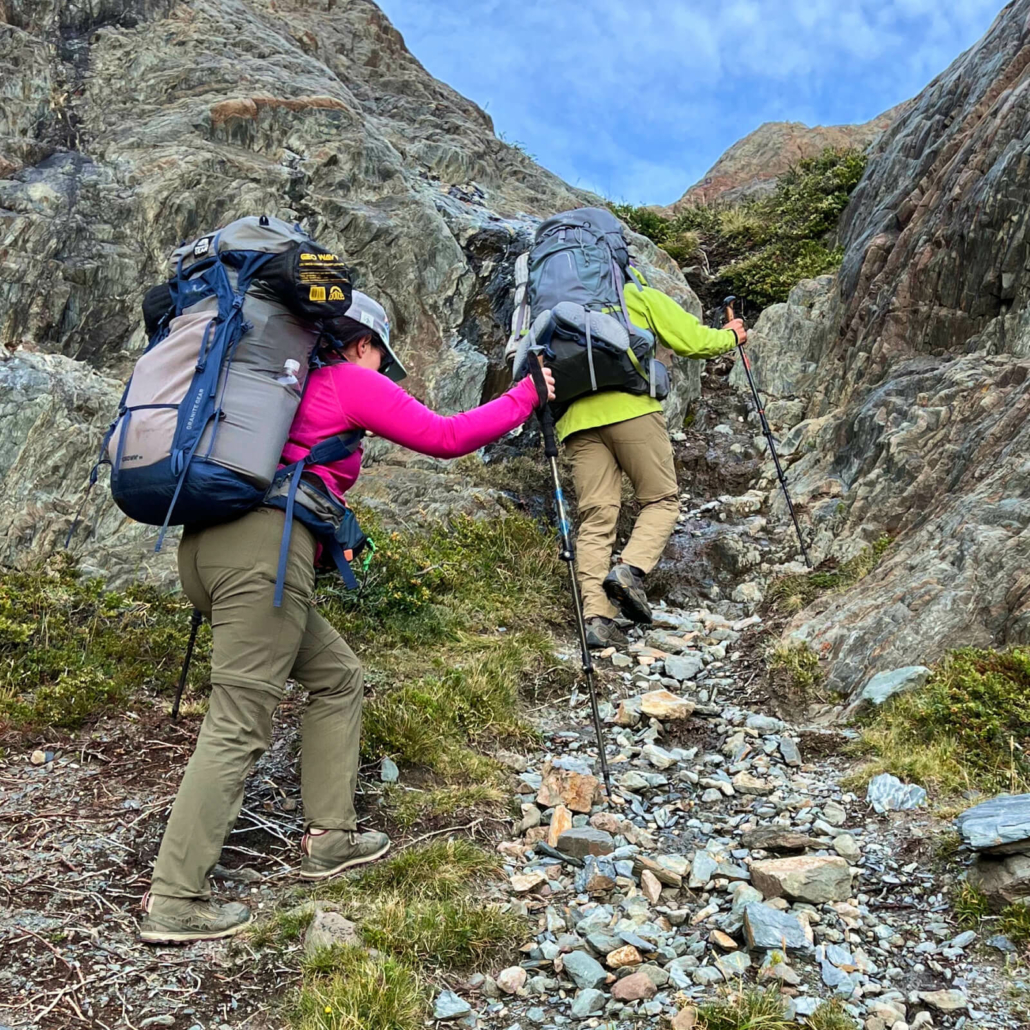
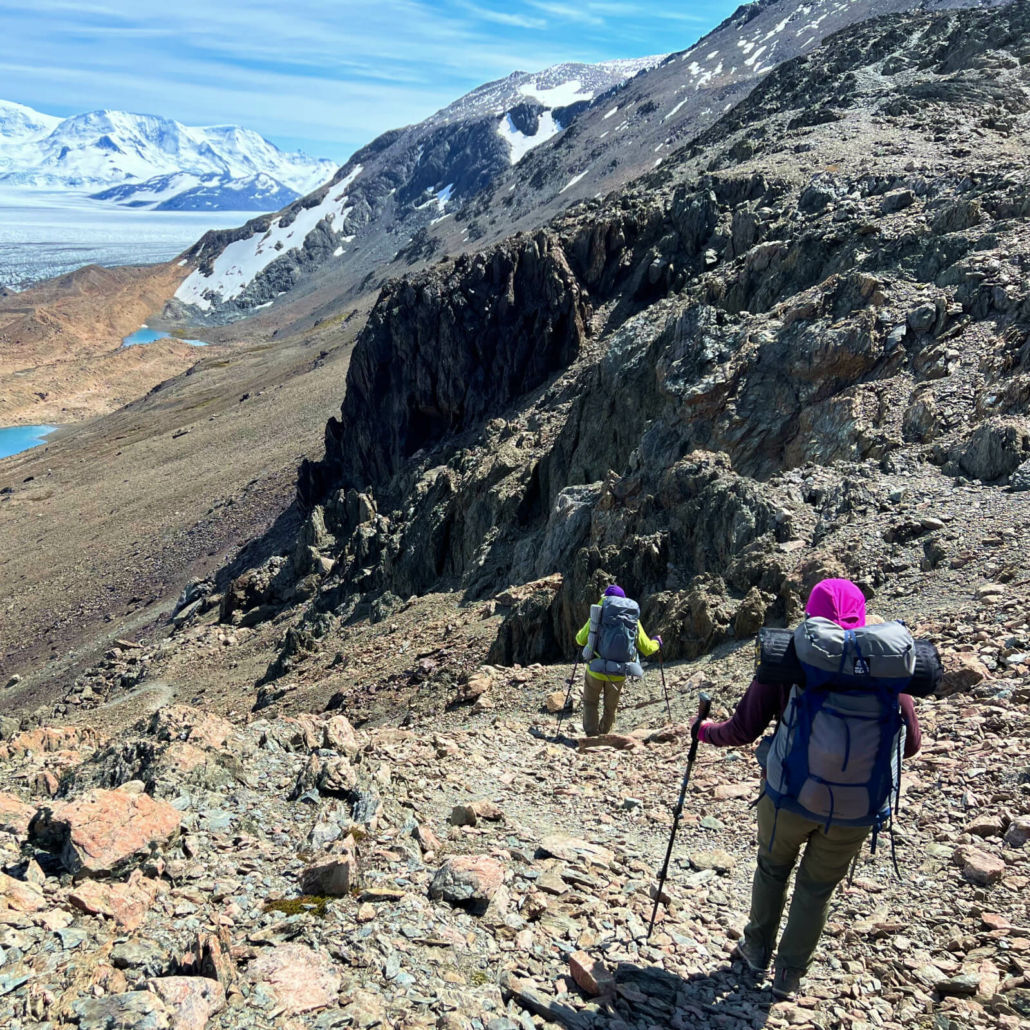
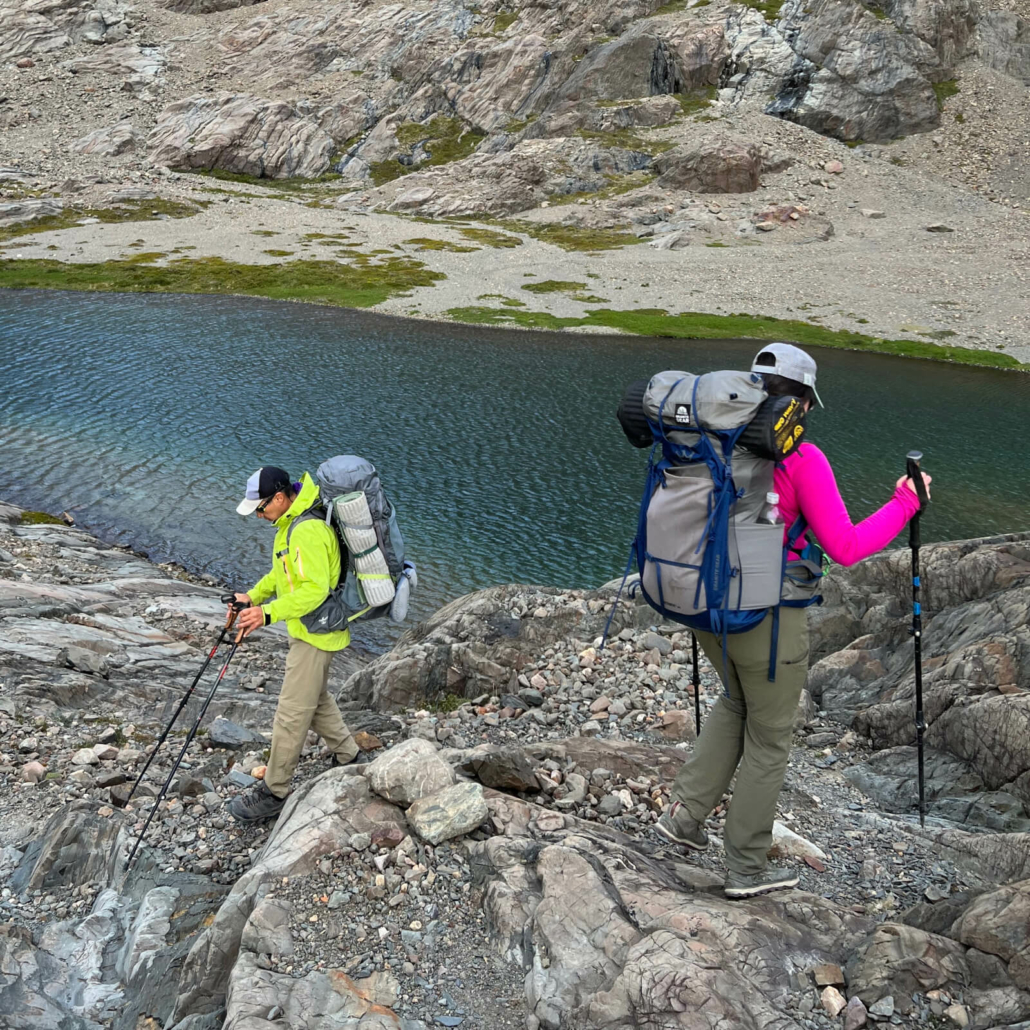
I have seen the CMT poles at Costco for a couple of years, seasonally, at $35. Great value if available to you.
Great tip! Thanks for sharing.
Hi!
What do You think, which trekking poles are the best for Camino routes- Leki Black Series FX Carbon or Black Diamond Distance Carbon FLZ Trekking Poles?
Thank you!
Gearing up! Love it. They’d both work, of course. But I’d lean towards the BD poles here, because they’re lighter weight and less expensive, and you likely won’t push the durability envelope, so the slightly heavier duty-ness of the Leki poles won’t matter much.
What’s very interesting is that you point out that the Leki pokes are heavier, while the BD is lighter.
Do you have correct LEKI data in your table?
The official LEKI website contains different parameters.
Leki Black Series FX Carbon is 228 grams (8 oz) and Black Diamond Distance Carbon FLZ is 340 grams (12 oz).
Could it be like that?
Leki is listing that 8 oz weight on a per pole measurement, where as the 12 oz BD weight is for the pair. We’ve just tried to normalize the data, so it appears differently on our site than on theirs.
Usually is given weight per pair. Doesn’t believe a bit that Leki weight 8 oz is per one pole, because they are very expensive poles and in that price the weight of poles at 455 grams will be awful. I wrote an email to the official representative. I’ll give you a message about the answer.
Yeah, you’re right. The specified weight is per one pole and that is awful:)
Thank you for paying attention to the LEKI pointing weight per unit.
Yeah, the weight is a bit higher than we’d prefer, but still within the range for light-not-ultralight, similar to some other carbon options in our guide. But the quality is there!
For my purposes I prefer a hiking stick. I bought mine from the Brazos Walking Stick company in Texas. It is strong enough to bear all of my weight going up a steep bank or going down hill. I always place my walking stick on the other side of a rock or log in case of snakes. It may be handy for defense against dangerous animals or just act like it. I have stepped in rodent burrows and the walking stick prevented my from falling and possible injury. I am out in the desert or mountains at least one day per week. I am a wildlife photographer. I have some shots of a mountain lion, bears, coyotes, snakes, pigs. etc.
I always enjoy your reviews and comments
Hi Alan- if you had to choose a grip on the CMT would you go with cork or other? $44.99 with non-cork now through your link at Amazon. Not a big difference in cost to cork. Thanks!
Timothy, Alison & I prefer the cork grips, slightly better feel and a little less damp feeling on warm days. But the lower cost, foam grips are fine. Your choice. Warmest, -alan & alison
Thanks Alan! If you were choosing btwn CMT and Massdrop X Fizan what would you go with. Again, thanks for the help!!!
Tim, this has already been discussed here. Please let me know if you have further Qs after reading it. Best, -alan
So, for the sub-100/value poles. Is the $10-$15 price difference between the Cascade Mtn, and MassDrop Fizan poles worth the 4 oz in weight savings?
Is the durability of the Fizan’s higher since they are all aluminum.
Thanks.
Ed, the answer is it depends. I think the flip locks on the CMT poles are less likely to jam and need less maintenance. It’s probably a wash on which shafts are stronger — although the Al is likely to survive a side load from a sharp edge like the edge of a talus block than Carbon. Do a bit of reading at the end of this post about Al vs. Carbon and Flick Locks vs. Twist Locks. Best, -alan
I have the Drop (formerly known as MassDrop) Fizan pole. I love them. Light weight and easy to adjust. I haven’t had one slip or jam. I’ve done several dozen hikes with them. Including 14ers and a week long Grand Canyon backpack on primitive trails. I think they’re a steal at $60. I have other heavier poles and can tell the difference when using them. These have a light swing weight (i.e., heavier at the top and lighter at the bottom)
OH! The only issues are a sweaty grips that Alan mentioned. I got use to it. The straps would lose adjustment. I adjusted mine to where I liked them, the secured the bottom of the the strap to the pole with a zip tie. Easy Peasy! Once I figured it out. If I wanted to wear thick glove with them, I would have to remove the zip tie. But if it’s that cold, I’m cross country skiing or snowshoeing with different poles. The tops are small for palming on the downhill. I’ve been think about gluing a half racket ball or squash ball to the top for more surface area.
Hi Aubrey, checkout the sun gloves in the guide. I think you’ll find they do wonders with trekking pole grips. I use them all the time. Best, -alan
Yup Aubrey, a nice set of light poles for only $60!
Thanks for a great round-up of poles! I particularly like your durability rating – great information to have.
I use Pacer Poles most of the time – they have a unique grip and different balance. They are slightly heavier but many people swear by them.
Another option for fixed poles (provided they are short enough) is to use a pole jack, which many tarp tent vendors sell.
My experience with the FL-Z poles is they are great, but sometimes an end of the joint falls deep into the section and pliers are needed to fish it out. Also, the tips on my pair aren’t thin enough to use with most tarp tent grommets, although maybe I can swap those out.
A hiking partner of mine had one of his carbon poles shear in half coming down Mt. Whitney – happily it was the last day of our hike, but I feel aluminum poles has less catastrophic failure modes. That said, Philip Werner shared that his poles break much less now that he’s using snow baskets all the time. I’ll have to try the Kevlar tape trick.
JP the kevlar tape is a factory applied layer(s) on the tip of the pole. Not something a user could do unless you wanted to epoxy it on like a layer of fiberglass. -a
Alan. I really appreciate your research and product comparisons. While the various types of pole uses adds complexity. I think summarizing your results in table form is super helpful. As an aside. I purchased the Cascade poles and used them on an 80 mile hike on the Uinitas Highline Trail this June. They performed great. Thanks!
Hi Matt, Gald the CMT poles worked for you. And there actually is a data table for the guide. It’s just a few days behind this post in publishing. Best, -alan
I totally enjoy your site and appreciate your product reviews and “how-to’s
Thanks, Jerry. Pass it on to friends. Best, -alan